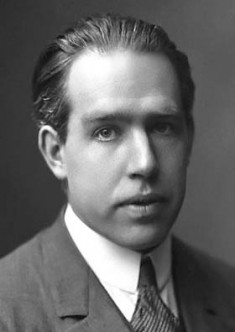| Niels Bohr | |
|---|---|
 |
|
| Physicist | |
| Specialty | Atomic structure, quantum theory |
| Born | Oct. 7, 1885 Copenhagen, Denmark |
| Died | Nov. 18, 1962 (at age 77) Copenhagen, Denmark |
| Nationality | Danish |
Born on October 7, 1885, Niels Henrik David Bohr was mostly known for his theories and contribution to physics, defining the atomic structure, and formulating the quantum theory that got him a Nobel Prize in Physics in 1922.
Early Life
Born in a family of three children in Copenhagen, Denmark, Bohr was influenced by his father who was a professor at the University of Copenhagen. He studied at the Gammelholm Latin School and later graduated the university where his father was a professor. His interests were mainly astronomy and mathematics.
Contributions to Physics
In 1911, Niels Bohr traveled to Cambridge, England, where he began most of his theoretical work in atomic structure and molecules. One year later, he returned home for his wedding and started giving lectures on thermodynamics. Shortly after, he published “the trilogy” in the Philosophical Magazine in July of 1913. The paper presented the Bohr model of the atom that was an adaptation of Rutherford’s nuclear structure to the quantum theory formulated by Max Planck.
During that time, he was also teaching a group of medical students at the University of Copenhagen. Because he did not enjoy his activity in the University, he traveled back to Manchester where he replaced Darwin as a reader in Rutherford. During that time, World War I broke out and he was forced to remain in England until 1916. When he returned to Denmark, he was given the Chair of Theoretical Physics within the University of Copenhagen.
On March 3, 1921, with the aid of many donations and the support of the Danish government, the Niels Bohr Institute opened its doors. It would become the prime center of research for quantum mechanics where many physicists would gather and elaborate on their theories.
One year later, Bohr received the Nobel Prize in Physics for his investigation and discovery of the structure of the atoms and their radiation.
Bohr’s Post 1922 Career
In November of 1925, the introduction of the spin in quantum mechanics by two scientists led Bohr to express his concerns about the interactions between electrons and magnetic fields. This new discovery led him to conduct his own research and discovered that light behaves like waves and particles. In 1927, experiments were conducted that confirmed that matter can behave like waves.
 By 1928, Bohr abandoned the law of conservation of energy and started his research on Enrico Fermi’s neutrino. In 1936, he explained how neutrons could be theoretically captured by the nucleus.
By 1928, Bohr abandoned the law of conservation of energy and started his research on Enrico Fermi’s neutrino. In 1936, he explained how neutrons could be theoretically captured by the nucleus.
His attention was again focused on quantum mechanics when nuclear fission was discovered in 1938. Bohr concluded that uranium-235 is not responsible for the fission but the uranium-238 despite everyone else’s belief. His statement was demonstrated to be true by John R. Dunning in 1940.
His activity and research got him involved in the Manhattan Project. In December of 1943, he arrived in Washington where Bohr met the director of the project. Over the course of two years, he conducted a series of visits to Los Alamos in New Mexico where nuclear weapons were being developed. Bohr was credited as one of the key contributors that helped build the weapon, but according to one scientist, they did not need his help.
In June of 1950, Bohr called for international aid on developing nuclear energy. The Soviet Union helped with the development of Bohr’s concept of energy generation but tested their first nuclear weapon as well.
Bohr’s Later Years
After World War Two, Bohr’s activity demonstrated that physics require significant financial resources. Bohr wanted his institute to host the CERN Theory Group, but there were disagreements. As a result, in 1957, it was moved from Copenhagen to Geneva.
Bohr’s Death and Legacy
By the end of the same year, the Scandinavian countries established their Nordic Institute for Theoretical Physics and got Bohr appointed as chairman. He was also a founding member of the Danish Atomic Energy Commission for which he served until 1956. Six years later, on November 18, 1962, Niels Bohr died of heart failure in his house in Carlsberg, Denmark
Niels Bohr received multiple honors and awards with the Nobel Prize as one of his most important recognitions for his research. He was awarded with the Hughes Medal in 1921 and the Matteucci Medal two years later. Towards the end of his life, Bohr received the Order of the Elephant Award in late 1947 and 10 years later, the Atoms for Peace Award.
His work influenced World War II and helped with the development of the atomic bomb and nuclear energy. Most of his theories are still being lectured about today in universities and used in quantum mechanics.